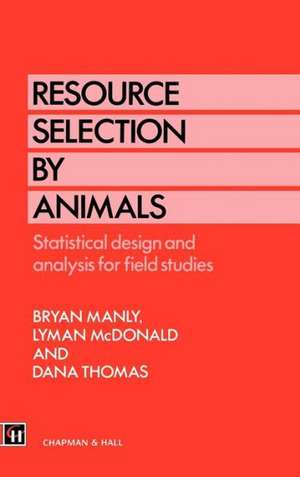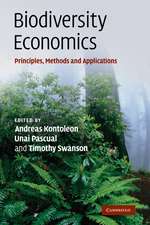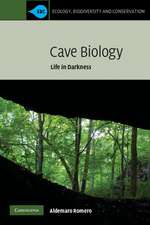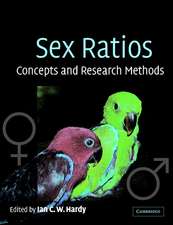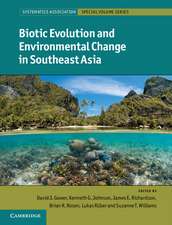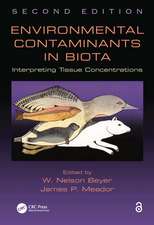Resource Selection by Animals: Statistical design and analysis for field studies
Autor B. B. Manly, L. McDonald, D.L. Thomasen Limba Engleză Hardback – 31 dec 1992
| Toate formatele și edițiile | Preț | Express |
|---|---|---|
| Paperback (1) | 939.77 lei 6-8 săpt. | |
| SPRINGER NETHERLANDS – 28 aug 2013 | 939.77 lei 6-8 săpt. | |
| Hardback (1) | 946.24 lei 6-8 săpt. | |
| SPRINGER NETHERLANDS – 31 dec 1992 | 946.24 lei 6-8 săpt. |
Preț: 946.24 lei
Preț vechi: 1153.95 lei
-18% Nou
Puncte Express: 1419
Preț estimativ în valută:
181.09€ • 187.07$ • 150.71£
181.09€ • 187.07$ • 150.71£
Carte tipărită la comandă
Livrare economică 25 martie-08 aprilie
Preluare comenzi: 021 569.72.76
Specificații
ISBN-13: 9780412401404
ISBN-10: 0412401401
Pagini: 177
Ilustrații: XIII, 177 p.
Dimensiuni: 155 x 235 x 17 mm
Greutate: 0.47 kg
Ediția:1993
Editura: SPRINGER NETHERLANDS
Colecția Springer
Locul publicării:Dordrecht, Netherlands
ISBN-10: 0412401401
Pagini: 177
Ilustrații: XIII, 177 p.
Dimensiuni: 155 x 235 x 17 mm
Greutate: 0.47 kg
Ediția:1993
Editura: SPRINGER NETHERLANDS
Colecția Springer
Locul publicării:Dordrecht, Netherlands
Public țintă
ResearchCuprins
1. Introduction to resource selection studies.- 1.1 Motivation and definitions.- 1.2 The data for resource selection studies.- 1.3 Sampling designs.- 1.4 Sampling protocols.- 1.5 Indices of selection.- 1.6 Hypothesis tests and confidence intervals.- 1.7 Discussion.- 2. Examples of the use of resource selection functions.- 2.1 Introduction.- 2.2 Examples.- 2.3 Sample designs.- 2.4 Assumptions.- 3. Statistical modelling procedures.- 3.1 Simple sample comparisons.- 3.2 Testing coefficients of individual X variables.- 3.3 Log-likelihood chi-squared tests.- 3.4 Analysis of residuals.- 3.5 Multiple tests and confidence intervals.- 4. Studies with resources defined by several categories.- 4.1 Introduction.- 4.2 Sampling designs and protocols.- 4.3 Ratios of random variables.- 4.4 Chi-squared tests.- 4.5 Design I with known proportions of available resource units.- 4.6 Tests on proportions of used units.- 4.7 Inferences concerning selection ratios.- 4.8 Comparison of selection ratios.- 4.9 Design I with estimated proportions of available resource units.- 4.10 Design II with sampling protocol A.- 4.11 Census of available resource units.- 4.12 Sample of available resource units.- 4.13 Design III with sampling protocol A.- 4.14 Census of available resource units.- 4.15 Sample of available resource units.- 4.16 Discussion.- 5. Estimating a resource selection probability function from a census of resource units using logistic regression.- 5.1 Introduction.- 5.2 Estimating the logistic function.- 5.3 Discussion.- 6. Estimating resource selection probability functions from a census of resource units at several points in time using the proportional hazards model.- 6.1 Introduction.- 6.2 Estimating the proportional hazards function.- 6.3 Discussion.- 7. Estimating a resource selection function from samples of resource units using proportional hazards and log-linear models.- 7.1 Introduction.- 7.2 Expected sample frequencies for resource units.- 7.3 The proportional hazards model.- 7.4 Small proportion of resource units used.- 7.5 Only samples of unused resource units available.- 7.6 Estimating parameters from sample data.- 7.7 Inferences with sample data.- 7.8 Recommendations.- 8. Estimating a resource selection function from two samples of resource units using logistic regression and discriminant function methods.- 8.1 Logistic regression.- 8.2 Linear discriminant function analysis.- 8.3 Quadratic discriminant function analysis.- 8.4 Discussion.- 9. General log-linear modelling.- 9.1 Introduction.- 9.2 Fitting models to data.- 10. Analysis of the amount of use.- 10.1 Introduction.- 10.2 Analysis of counts of the amount of use.- 10.3 Analysis of continuous measures of the amount of use.- 10.4 Mixtures of zeros and positive measures of the amount of use.- 11. The comparison of selection for different types of resource unit.- 11.1 Variances for estimates and their differences.- References.- Author index.
Recenzii
`Bryan Manly has more experience than most in guiding the unwary biologist through unchartered statistical territory...this book will prove enlightening to the mathematically-minded biologist...'
Biodiversity and Conservation
`The authors...consider with a lot of care various types of design allowing to assess to which degree a resource is selected, with reference to its availability... Classification is illustrated with a few detailed examples from the literature, for which data are given. These examples are followed throughout the book, which makes the reading easy and pleasant...This book certainly meets its subtitle by giving a thorough and comprehensive overview of 'statistical design and analysis for field studies' of resource selection.'
Acta Oecologia
Biodiversity and Conservation
`The authors...consider with a lot of care various types of design allowing to assess to which degree a resource is selected, with reference to its availability... Classification is illustrated with a few detailed examples from the literature, for which data are given. These examples are followed throughout the book, which makes the reading easy and pleasant...This book certainly meets its subtitle by giving a thorough and comprehensive overview of 'statistical design and analysis for field studies' of resource selection.'
Acta Oecologia
